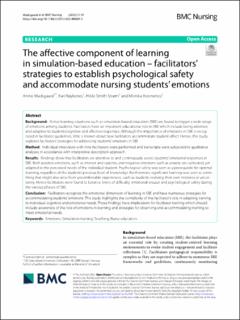| dc.contributor.author | Madsgaard, Anine | |
| dc.contributor.author | Røykenes, Kari | |
| dc.contributor.author | Smith-Strøm, Hilde | |
| dc.contributor.author | Kvernenes, Monika | |
| dc.date.accessioned | 2023-02-15T08:54:17Z | |
| dc.date.available | 2023-02-15T08:54:17Z | |
| dc.date.created | 2022-04-28T12:27:38Z | |
| dc.date.issued | 2022 | |
| dc.identifier.citation | BMC Nursing. 2022, 21 (1), Article number: 91, | en_US |
| dc.identifier.issn | 1472-6955 | |
| dc.identifier.uri | https://hdl.handle.net/11250/3050935 | |
| dc.description | This article is licensed under a Creative Commons Attribution 4.0 International License, which permits use, sharing, adaptation, distribution and reproduction in any medium or format, as long as you give appropriate credit to the original author(s) and the source, provide a link to the Creative Commons licence, and indicate if changes were made. The images or other third party material in this article are included in the article’s Creative Commons licence, unless indicated otherwise in a credit line to the material. If material is not included in the article’s Creative Commons licence and your intended use is not permitted by statutory regulation or exceeds the permitted use, you will need to obtain permission directly from the copyright holder. To view a copy of this licence, visithttp://creativecommons.org/licenses/by/4.0/. The Creative Commons Public Domain Dedication waiver (http://creativeco mmons.org/publicdomain/zero/1.0/) applies to the data made available in this article, unless otherwise stated in a credit line to the data.. | en_US |
| dc.description.abstract | Background: Active learning situations such as simulation-based education (SBE) are found to trigger a wide range of emotions among students. Facilitators have an important educational role in SBE which include being attentive and adaptive to students’cognitive and afective responses. Although the importance of emotions in SBE is recog nized in facilitator guidelines, little is known about how facilitators accommodate student afect. Hence, this study explores facilitators’ strategies for addressing students’ emotions in SBE.
Method: Individual interviews with nine facilitators were performed and transcripts were subjected to qualitative analyses in accordance with interpretive description approach.
Results: Findings show that facilitators are attentive to and continuously assess students’ emotional responses in SBE. Both positive emotions, such as interest and surprise, and negative emotions such as anxiety are cultivated, yet adapted to the perceived needs of the individual student. Psychological safety was seen as a prerequisite for optimal learning, regardless of the students’ previous level of knowledge. Furthermore, signifcant learning was seen as some thing that might also arise from uncomfortable experiences, such as students realizing their own mistakes or uncer tainty. Hence facilitators were found to balance levels of difculty, emotional arousal and psychological safety during the various phases of SBE.
Conclusion: Facilitators recognize the emotional dimension of learning in SBE and have numerous strategies for accommodating students’ emotions. This study highlights the complexity of the facilitator’s role in adapting training to individual cognitive and emotional needs. These fndings have implications for facilitator training which should include awareness of the role of emotions in learning and strategies for observing and accommodating training to meet emotional needs. | en_US |
| dc.language.iso | eng | en_US |
| dc.publisher | BioMed Central (BMC) | en_US |
| dc.rights | Navngivelse 4.0 Internasjonal | * |
| dc.rights.uri | http://creativecommons.org/licenses/by/4.0/deed.no | * |
| dc.subject | nurse education | en_US |
| dc.subject | teaching | en_US |
| dc.subject | simulation training | en_US |
| dc.subject | emotions | en_US |
| dc.title | The affective component of learning in simulation-based education – facilitators’ strategies to establish psychological safety and accommodate nursing students’ emotions | en_US |
| dc.type | Peer reviewed | en_US |
| dc.type | Journal article | en_US |
| dc.description.version | publishedVersion | en_US |
| dc.rights.holder | © The Author(s) 2022. | en_US |
| dc.source.pagenumber | 1-10 | en_US |
| dc.source.volume | 21 | en_US |
| dc.source.journal | BMC Nursing | en_US |
| dc.source.issue | 1 | en_US |
| dc.identifier.doi | 10.1186/s12912-022-00869-3 | |
| dc.identifier.cristin | 2019781 | |
| dc.source.articlenumber | 91 | en_US |
| cristin.ispublished | true | |
| cristin.fulltext | original | |
| cristin.qualitycode | 1 | |

